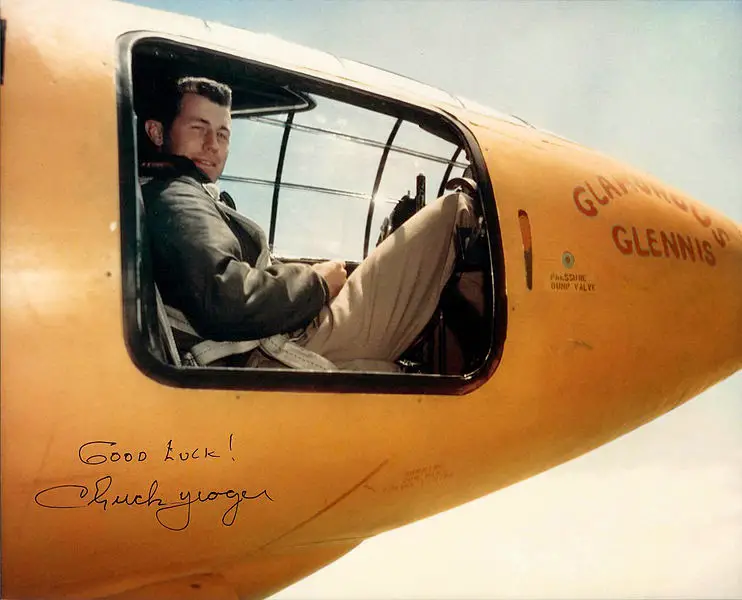 The weekly collection of useless and fun facts. In this week’s edition: Chuck Yeager, Bald Eagles, NASA, A Singing Road, and Canadian Tickets.
The weekly collection of useless and fun facts. In this week’s edition: Chuck Yeager, Bald Eagles, NASA, A Singing Road, and Canadian Tickets.
 Chuck Yeager, easily the most famed test pilot in human history, broke the sound barrier in the Bell X-1 experimental rocket plane. What is even more amazing is that he did it with two broken ribs. The breaks didn’t occur during the historic flight, they occurred on the ground the night before. Yeager had completed eight powered flights in the X-1 up to that point, and the next step was to take the plane to Mach .98. A dangerous maneuverability problem had been corrected, and it was felt the plane could be pushed further. The next flight would be after a weekend, and the night before he was to go up again, Yeager and his wife, Glennis (whose name had been used as a nickname for the X-1, the “Glamorous Glennis”) went out to dinner at a well-known, local establishment called Pancho’s. After their dinner, the couple took a pair of Pancho’s horses out for a ride. They raced the horses for the barn at the end of the ride, but a gate had been closed. Yeager’s horse struck the gate, threw him, and he landed on the ground. The result of the fall were two broken ribs. A couple of broken ribs would have grounded Yeager from flying so he got his wife to drive him to an off-base doctor who taped them up. Now the problem was he couldn’t close the cockpit of the plane. He told Jack Ridley, a fellow pilot and aeronautical engineer, about the problem, and Ridley made a handl out of a broomstick which would allow him to close the door. Ridley had also figured out the problems with the X-1’s maneuverability during the previous flight, and here he had come up with another fix, albeit a slightly unorthodox one. Yeager was able to close the door without a problem on the ground. When the flight took place later, Yeager was able to latch the cockpit before the historic flight. He got the plane to Mach .965 before the meter went off the scale. A sonic boom was heard on the ground, and Yeager flew past the speed of sound for twenty seconds.
Chuck Yeager, easily the most famed test pilot in human history, broke the sound barrier in the Bell X-1 experimental rocket plane. What is even more amazing is that he did it with two broken ribs. The breaks didn’t occur during the historic flight, they occurred on the ground the night before. Yeager had completed eight powered flights in the X-1 up to that point, and the next step was to take the plane to Mach .98. A dangerous maneuverability problem had been corrected, and it was felt the plane could be pushed further. The next flight would be after a weekend, and the night before he was to go up again, Yeager and his wife, Glennis (whose name had been used as a nickname for the X-1, the “Glamorous Glennis”) went out to dinner at a well-known, local establishment called Pancho’s. After their dinner, the couple took a pair of Pancho’s horses out for a ride. They raced the horses for the barn at the end of the ride, but a gate had been closed. Yeager’s horse struck the gate, threw him, and he landed on the ground. The result of the fall were two broken ribs. A couple of broken ribs would have grounded Yeager from flying so he got his wife to drive him to an off-base doctor who taped them up. Now the problem was he couldn’t close the cockpit of the plane. He told Jack Ridley, a fellow pilot and aeronautical engineer, about the problem, and Ridley made a handl out of a broomstick which would allow him to close the door. Ridley had also figured out the problems with the X-1’s maneuverability during the previous flight, and here he had come up with another fix, albeit a slightly unorthodox one. Yeager was able to close the door without a problem on the ground. When the flight took place later, Yeager was able to latch the cockpit before the historic flight. He got the plane to Mach .965 before the meter went off the scale. A sonic boom was heard on the ground, and Yeager flew past the speed of sound for twenty seconds.
 |
| Saffron Blaze/wikimedia |
In 1782, the bald eagle was chosen as the National Emblem of the United States, but that isn’t the only remarkable thing about this bird. A bald eagle uses its feathers for balance, and if it loses a feather on one side, it will lose the same feather on the other side to remain perfectly balanced. Bald eagles have over 7,000 feathers that are extremely lightweight but very strong. They are made of keratin, the same substance that make up their talons and beak. It’s also the same substance that makes up human fingernails and toenails. Just like fingernails, an eagle’s new feather will push out an old one as it grows. If you ever find an eagle feather, don’t even think about keeping it. It’s against the law and illegal to possess any part of an eagle. You’re required to give any parts, feathers included, over to the proper authorities.
 NASA will be spending $3 million from December 2012 to December 2017 to try to understand one of the greatest mysteries to mankind (and womankind) – how exactly Congress works. It’s all a part of an annual, week-long seminar with Georgetown University called the “Congressional Operations Seminar” on Capitol Hill. The seminar is described as looking at how, “Congress is organized, the key players and their roles, and how the legislative process really works.” In addition, it will look at how Congress affects departments and agencies in the Executive Branch of government. The thought has been echoed that there is no reason to look at something that is never really understood anyway. But the real reason might be that NASA wants to figure out how Congress makes their decisions so when appropriations time comes up, they can better understand it. Good luck on that one.
NASA will be spending $3 million from December 2012 to December 2017 to try to understand one of the greatest mysteries to mankind (and womankind) – how exactly Congress works. It’s all a part of an annual, week-long seminar with Georgetown University called the “Congressional Operations Seminar” on Capitol Hill. The seminar is described as looking at how, “Congress is organized, the key players and their roles, and how the legislative process really works.” In addition, it will look at how Congress affects departments and agencies in the Executive Branch of government. The thought has been echoed that there is no reason to look at something that is never really understood anyway. But the real reason might be that NASA wants to figure out how Congress makes their decisions so when appropriations time comes up, they can better understand it. Good luck on that one.
 The Civic Musical Road in Lancaster, California, had originally been made for a Honda commercial in September 2008. It has grooves in the road, and when driving at 55 mph, your car will magically play the finale of Rossini’s “The William Tell Overture“. Originally the road had been constructed in another location, but noise complaints from the neighbors caused the city to pave over it. I guess they didn’t appreciate hearing the score over and over constantly. It was rebuilt on another street two miles away from any residential areas, giving the rabbits and coyotes something to hum along with. It’s a three-lane road and the musical grooves are in the far left lane, just in case you happen to be in the area. Can’t get enough of musical roads? There are also some in Japan, Holland, South Korea, and one in New Mexico that plays “America the Beautiful“. Listen to the “William Tell” road here.
The Civic Musical Road in Lancaster, California, had originally been made for a Honda commercial in September 2008. It has grooves in the road, and when driving at 55 mph, your car will magically play the finale of Rossini’s “The William Tell Overture“. Originally the road had been constructed in another location, but noise complaints from the neighbors caused the city to pave over it. I guess they didn’t appreciate hearing the score over and over constantly. It was rebuilt on another street two miles away from any residential areas, giving the rabbits and coyotes something to hum along with. It’s a three-lane road and the musical grooves are in the far left lane, just in case you happen to be in the area. Can’t get enough of musical roads? There are also some in Japan, Holland, South Korea, and one in New Mexico that plays “America the Beautiful“. Listen to the “William Tell” road here.
 There are some police departments in Canada that thank their citizens for doing something good. They’re called “positive tickets”. They were started by Ward Clapham of the Richmond Royal Canadian Mounted Police in 2002 as a way to thank citizens for positive behavior. The program became almost too successful as some of Clapham’s officers began to complain that they sometimes couldn’t get their work done because of being too popular, as kids would see the police cars and rush toward them, wanting to be ticketed. They even modified the tickets so there would be a tear-off portion as a keepsake to remind the kid of doing good, and a portion that could be redeemed for a reward, such as pizza, pool passes, or ice cream. The program continues to this day in other areas of Canada with the same goal in place – rewarding citizens for good behavior.
There are some police departments in Canada that thank their citizens for doing something good. They’re called “positive tickets”. They were started by Ward Clapham of the Richmond Royal Canadian Mounted Police in 2002 as a way to thank citizens for positive behavior. The program became almost too successful as some of Clapham’s officers began to complain that they sometimes couldn’t get their work done because of being too popular, as kids would see the police cars and rush toward them, wanting to be ticketed. They even modified the tickets so there would be a tear-off portion as a keepsake to remind the kid of doing good, and a portion that could be redeemed for a reward, such as pizza, pool passes, or ice cream. The program continues to this day in other areas of Canada with the same goal in place – rewarding citizens for good behavior.
Until next time, remember that you’re prepared with all the facts behind the facts to annoy those around you with your new found knowledge. Have fun!
Other editions of the Completely Random Facts of the Week

